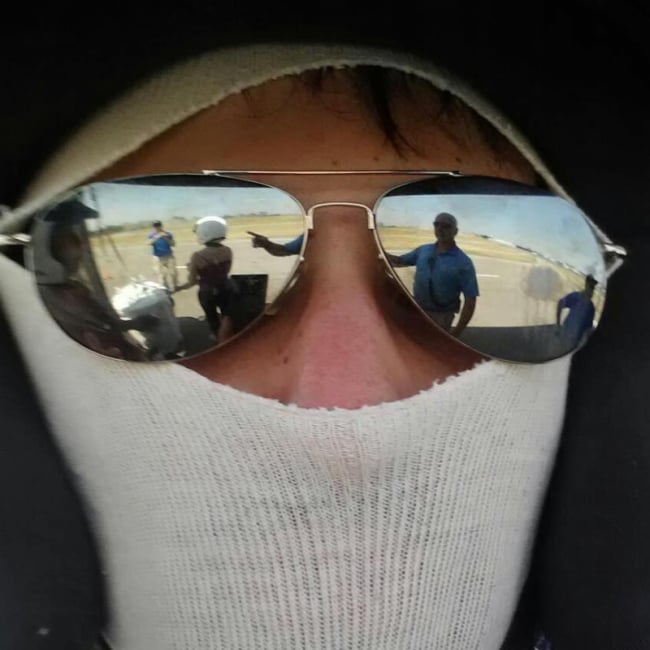Back at the height of the muscle car era, you could leisurely walk in and buy a street legal race car right off the showroom floor for the most part. This was because NASCAR rules stipulated that in order for a car and engine to compete, at least 500 examples had to be sold to the general population. Ford, wanting to compete against the seemingly invincible 426 HEMI, answered the call with the 1969 (and 1970) BOSS 429 Mustangs. Less than 1,400 of these Mustangs were ever made, and a lot of effort went into wedging the massive engine under the hood, making it amongst the most unique and desirable Mustangs ever built. Yet, even more valuable – and infinitely rarer – were the two Mercury Cougars that were also fitted with BOSS 429 engines. So what ever happened to these one-hit wonders?
The Mercury Cougar, which debuted in 1967, was marketed as “the gentleman’s muscle car.” Essentially a re-bodied Mustang with a longer wheelbase, it was one of the few vehicles in the Ford lineup that could only be ordered with a V8. For 1967, this meant a choice between the 289 or 390, and by 1970, your choices had expanded to include the 302, BOSS 302, 351 (Windsor and Cleveland), and 428 engines.
The Cougar was, in many ways, a mirror of the Mustang up through 1973. In 1974, the Cougar lost its muscle car identity completely and became more of an entry-level luxury barge, while the more-compact Mustang II came in 1974 sans a V8 option. Yet, mysteriously absent from those early years was the BOSS 429 engine option, which could be ordered on the Mustang during the ’69 and ’70 model runs. Actually, not quite. Ford did commission just two 1969 Mercury Cougars with the semi-hemispherical BOSS 429 engine built, and sold both of them for $1 a piece to two famous drag racers. Designated by Mercury as “clinic cars,” the two BOSS 429 Cougars toured through dealerships teaching Ford gearheads all about horsepower.
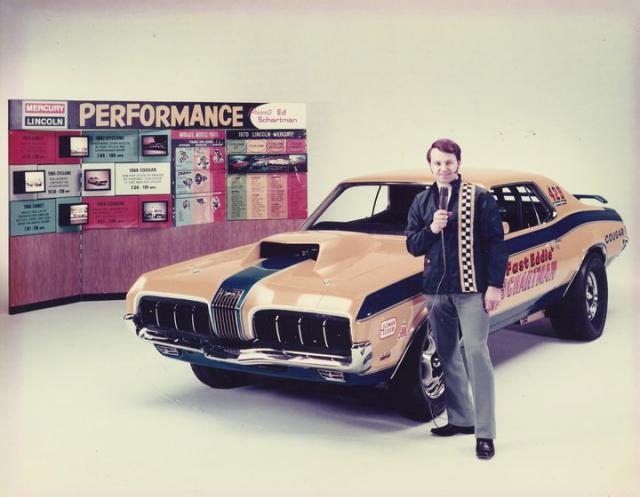
Schartman used his BOSS 429 Cougars as a “clinic” car, helping teach eager gearheads all about building high-performance machines.
The two drag racers Mercury choose were none other than “Dyno Don” Nicholson and “Fast Eddie” Schartman. These two men were on the front lines of Ford’s war against Chrysler, and competed with much fanfare and success with their flop-top funny car Cougars. However, Ford felt the funny cars were more of a liability than a boon, and wanted to showcase something more people could relate to. Thus, Ford entered into the Super Stock class.
Like the Mustangs, the Cougars required a lot of work to fit the 429 engine between the shock towers. They were sent to Kar Kraft in Brighton, Michigan, to be modified to receive these engines. The BOSS 429’s “semi-HEMI”design made it a very wide engine requiring the shock towers to be moved outwards one inch in either direction, creating an additional two inches of clearance. The lower A-arms also had to be dropped an inch to accommodate the engine, and even then, a massive hood scoop (the largest ever on a Mustang) was needed to ensure the hood could close. Even the battery had to be relocated to the trunk. These were big engines, even at a time when big engines were common.
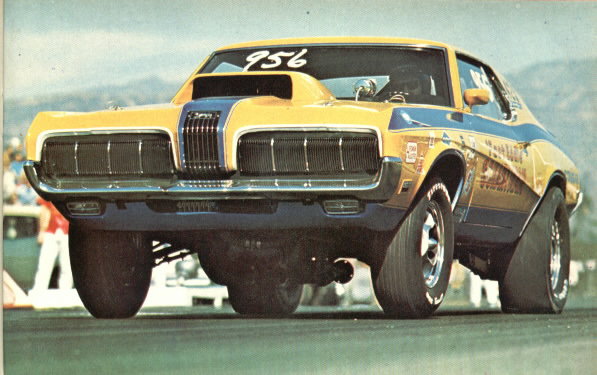
"Fast Eddie" Schartman's car kept the 429 BOSS engine, but swapped to a fiberglass front end from a '70 Cougar
Dyno Don immediately ditched the 429 engine, replacing it with the even rarer 427 Ford SOHC “Cammer” engine and he painted his car red. Fast Eddie kept the 429 engine and the white hue, but converted his Cougar over to a 1970 hood and front clip. Both of these cars had fiberglass front panels, which technically disqualified them from running in Super Stock. However, the cars were reportedly so slow that nobody really seemed bothered, and they were hardly raced anyway. Both Cougars were supposed to be returned to Ford, and in all likelihood were destined for the crusher. Curiously, neither car was returned to Ford, and the Cougars disappeared.
In fact, like so many famous muscle cars, these two Cougars were, for a time, lost to history. Unlike the BOSS 429 Mustangs, which received the special Z-code stamping, these were just regular R-code Cougars. The R-code Cougar was equipped with the 428 Cobra Jet engine, which while still rare and desirable, was no BOSS 429 engine. Nobody really seemed to care about these cars initially though, as they were not seen as great competitors. It would be decades before interest in these rare cats returned as the rarity and desirability of BOSS Mustangs peaked.
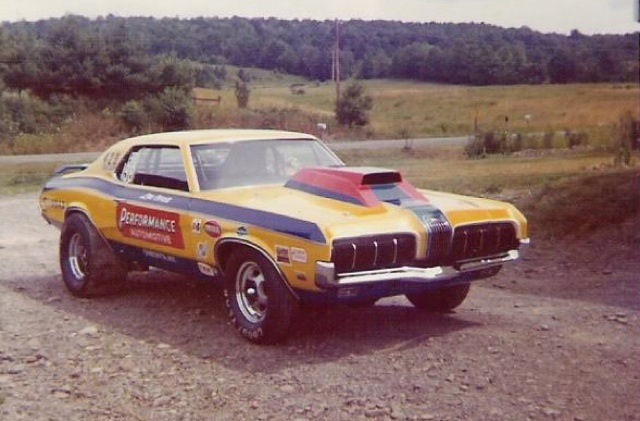
Schartman was supposed to return his Cougar to Ford when he was done with it, but instead he listed it for sale in National Dragster in 1971. Lou Cerra bought the car and raced it through 1973.
Conservatively rated at 375 horsepower for legal and insurance reasons, it is largely rumored that the BOSS 429 engine made closer to 500 horsepower. While based on the NASCAR-racing 429 engine, the street-going 429 was milder, yet still ridiculously powerful. Its most famous feature was the aluminum cylinder heads, but they also featured a forged crankshaft and connecting rods. In terms of racing performance though, the stock street BOSS 429 engine was on par with the 428 Cobra Jet, which is why Dyno Don ditched his engine in favor of the 427 Cammer. Fast Eddie only raced the Cougar three or four times, instead using it to teach muscle car clinics about how to make horsepower.
While the engine was a bit of a snoozer from the factory, adding a few bolt-on modifications made these engines really hummed with high horsepower. Thanks to the forged internals, they could handle almost anything that was thrown at them as well, which is one reason why they have such an enduring legacy.
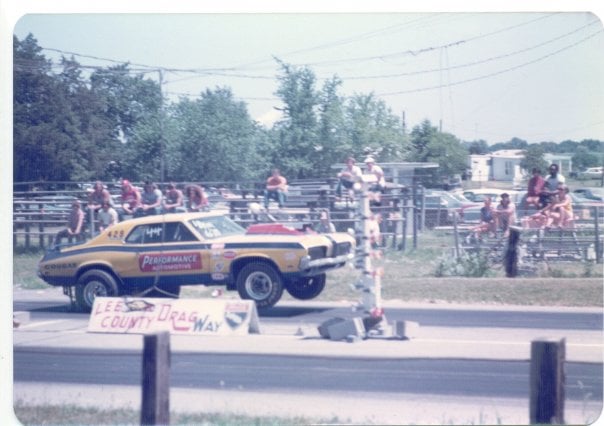
Steve Comstock bought the car in 1974 and dropped a Holmann & Moody 454ci BOSS engine in the Cougar, racing it for several years before selling it to the current owner, Doug Herzog
Compared to today’s media blitz for the 2012 BOSS Mustang, Ford did almost nothing to market the Boss 429 Mustang. Only sharp-eyed customers or those in-the-know thought to order these cars. Ford only sold the engine in production cars so that NASCAR would let them compete with it in races. Desperate to compete against the HEMI, Ford had to sell 500 BOSS 429 engines to the public if they wanted to compete. While the original goal was to sell just 500 of these cars in 1969, 857 Mustangs – and consequently the two Cougars – were built with the BOSS 429 engine. In 1970, 499 BOSS Mustangs were built, and zero Cougars.
Even with the lack of advertising for the darling Mustang, Ford still sold more than it needed to. That was the gravity of this engine. Alas, it also meant that there was never any hope for a production BOSS 429 Cougar, as they were created simply as promotional tools more so than serious racers. Yet, what ever happened to Fast Eddie’s Cougar?
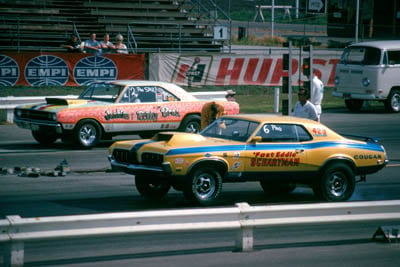
Fast Eddie's Cougar only made a handful of appearences at the track, and Schartman often complained that the car was too slow.
Fast Eddie’s car was sold in 1971 to Lou Cerra, who replaced the engine and raced it through 1973. It was then sold to Steve Comstock, who dropped a 454ci Holmann & Moody BOSS engine into it. It was raced for a few years before the body was twisted something fierce. These Cougars, despite being built for racing, lacked many important features like sub-frame connectors or a real roll cage (a bolt-in kit was used instead). It sat around unloved for awhile before being bought by Douglas Herzog, a racing engine builder and 429 aficionado.
Doug has taken to restoring this prestigious car with the help of a number of sponsors in the hopes of restoring some of its former glory. He plans to make some minor, yet important updates that will allow him to actually race the car when he is done. He has started a Facebook page where you can become a fan and watch the progress of the resurrection of this amazing car.
While everybody still recognizes the BOSS 429 Mustang as the awesome muscle car that it is, we sometimes forget about the many other muscle cars that it once shared the stage with. None were closer than the Cougar, and for a little while, the frisky kitty stole some of the spotlight from the Mustang. While Mercury will be phased out by the end of this year, the enduring legacy of cars like the 429 BOSS Cougar still manage to sink their claws into us and take us back to a time when horsepower was king and muscle cars ruled the roads.
CHECK OUT OTHER MUSCLE CARS YOU SHOULD KNOW
- ’69 Royal Bobcat Pontiac GTO Ram Air V
- ’87 Buick Regal GNX
- ’69 Ford Mustang BOSS 302 George Follmer’s #16
- ’69 Ford Mustang BOSS 429
- ’69 Dodge Charger Daytona #88
- ’69 Motion Chevrolet Camaro Z/28 427 ZLX
- ’69 Motion Hurst/Oldsmobile 455


